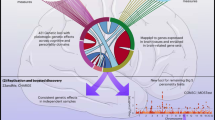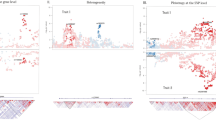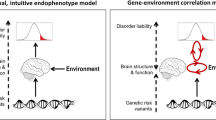Abstract
Personality is influenced by genetic and environmental factors1 and associated with mental health. However, the underlying genetic determinants are largely unknown. We identified six genetic loci, including five novel loci2,3, significantly associated with personality traits in a meta-analysis of genome-wide association studies (N = 123,132–260,861). Of these genome-wide significant loci, extraversion was associated with variants in WSCD2 and near PCDH15, and neuroticism with variants on chromosome 8p23.1 and in L3MBTL2. We performed a principal component analysis to extract major dimensions underlying genetic variations among five personality traits and six psychiatric disorders (N = 5,422–18,759). The first genetic dimension separated personality traits and psychiatric disorders, except that neuroticism and openness to experience were clustered with the disorders. High genetic correlations were found between extraversion and attention-deficit–hyperactivity disorder (ADHD) and between openness and schizophrenia and bipolar disorder. The second genetic dimension was closely aligned with extraversion–introversion and grouped neuroticism with internalizing psychopathology (e.g., depression or anxiety).
This is a preview of subscription content, access via your institution
Access options
Subscribe to this journal
Receive 12 print issues and online access
$209.00 per year
only $17.42 per issue
Buy this article
- Purchase on Springer Link
- Instant access to full article PDF
Prices may be subject to local taxes which are calculated during checkout



Similar content being viewed by others
References
Vukasović, T. & Bratko, D. Heritability of personality: a meta-analysis of behavior genetic studies. Psychol. Bull. 141, 769–785 (2015).
Okbay, A. et al. Genetic variants associated with subjective well-being, depressive symptoms, and neuroticism identified through genome-wide analyses. Nat. Genet. 48, 624–633 (2016).
Smith, D.J. et al. Genome-wide analysis of over 106,000 individuals identifies 9 neuroticism-associated loci. Mol. Psychiatry 21, 749–757 (2016).
Goldberg, L.R. The structure of phenotypic personality traits. Am. Psychol. 48, 26–34 (1993).
Trull, T.J. & Widiger, T.A. Dimensional models of personality: the five-factor model and the DSM-5. Dialogues Clin. Neurosci. 15, 135–146 (2013).
de Moor, M.H. et al. Meta-analysis of genome-wide association studies for personality. Mol. Psychiatry 17, 337–349 (2012).
de Moor, M.H. et al. Meta-analysis of genome-wide association studies for neuroticism, and the polygenic association with major depressive disorder. JAMA Psychiatry 72, 642–650 (2015).
Kim, H.N. et al. Genome-wide association study of the five-factor model of personality in young Korean women. J. Hum. Genet. 58, 667–674 (2013).
Bulik-Sullivan, B.K. et al. LD Score regression distinguishes confounding from polygenicity in genome-wide association studies. Nat. Genet. 47, 291–295 (2015).
Tabarés-Seisdedos, R. & Rubenstein, J.L.R. Chromosome 8p as a potential hub for developmental neuropsychiatric disorders: implications for schizophrenia, autism and cancer. Mol. Psychiatry 14, 563–589 (2009).
Greenwood, T.A., Akiskal, H.S. & Akiskal, K.K. Bipolar Genome Study & Kelsoe, J.R. Genome-wide association study of temperament in bipolar disorder reveals significant associations with three novel loci. Biol. Psychiatry 72, 303–310 (2012).
Green, E. et al. Localization of bipolar susceptibility locus by molecular genetic analysis of the chromosome 12q23-q24 region in two pedigrees with bipolar disorder and Darier's disease. Am. J. Psychiatry 162, 35–42 (2005).
Schizophrenia Working Group of the Psychiatric Genomics Consortium. Biological insights from 108 schizophrenia-associated genetic loci. Nature 511, 421–427 (2014).
Van Os, J. & Jones, P.B. Neuroticism as a risk factor for schizophrenia. Psychol. Med. 31, 1129–1134 (2001).
Åberg, K. et al. Genome-wide association study of movement-related adverse antipsychotic effects. Biol. Psychiatry 67, 279–282 (2010).
Rietveld, C.A. et al. Common genetic variants associated with cognitive performance identified using the proxy-phenotype method. Proc. Natl. Acad. Sci. USA 111, 13790–13794 (2014).
Poropat, A.E. A meta-analysis of adult-rated child personality and academic performance in primary education. Br. J. Educ. Psychol. 84, 239–252 (2014).
Giambartolomei, C. et al. Bayesian test for colocalisation between pairs of genetic association studies using summary statistics. PLoS Genet. 10, e1004383 (2014).
Power, R.A. & Pluess, M. Heritability estimates of the Big Five personality traits based on common genetic variants. Transl. Psychiatry 5, e604 (2015).
Barnett, J.H. et al. Personality and bipolar disorder: dissecting state and trait associations between mood and personality. Psychol. Med. 41, 1593–1604 (2011).
Hettema, J.M., Neale, M.C., Myers, J.M., Prescott, C.A. & Kendler, K.S. A population-based twin study of the relationship between neuroticism and internalizing disorders. Am. J. Psychiatry 163, 857–864 (2006).
Jakobwitz, S. & Egan, V. The dark triad and normal personality traits. Pers. Individ. Dif. 40, 331–339 (2006).
Kendler, K.S. & Myers, J. The genetic and environmental relationship between major depression and the five-factor model of personality. Psychol. Med. 40, 801–806 (2010).
Insel, T. et al. Research domain criteria (RDoC): toward a new classification framework for research on mental disorders. Am. J. Psychiatry 167, 748–751 (2010).
DeYoung, C.G. The neuromodulator of exploration: a unifying theory of the role of dopamine in personality. Front. Hum. Neurosci. 7, 762 (2013).
Power, R.A. et al. Polygenic risk scores for schizophrenia and bipolar disorder predict creativity. Nat. Neurosci. 18, 953–955 (2015).
Karalunas, S.L. et al. Subtyping attention-deficit/hyperactivity disorder using temperament dimensions: toward biologically based nosologic criteria. JAMA Psychiatry 71, 1015–1024 (2014).
Gray, J.A. The psychophysiological basis of introversion-extraversion. Behav. Res. Ther. 8, 249–266 (1970).
Mezquita, L. et al. Five-factor model and internalizing and externalizing syndromes: a 5-year prospective study. Pers. Individ. Dif. 79, 98–103 (2015).
Plomin, R., Haworth, C.M. & Davis, O.S. Common disorders are quantitative traits. Nat. Rev. Genet. 10, 872–878 (2009).
Hu, Y. et al. GWAS of 89,283 individuals identifies genetic variants associated with self-reporting of being a morning person. Nat. Commun. 7, 10448 (2016).
Pickrell, J.K. et al. Detection and interpretation of shared genetic influences on 42 human traits. Nat. Genet. 48, 709–717 (2016).
Falush, D., Stephens, M. & Pritchard, J.K. Inference of population structure using multilocus genotype data: linked loci and correlated allele frequencies. Genetics 164, 1567–1587 (2003).
Henn, B.M. et al. Cryptic distant relatives are common in both isolated and cosmopolitan genetic samples. PLoS One 7, e34267 (2012).
van den Berg, S.M. et al. Meta-analysis of genome-wide association studies for extraversion: findings from the Genetics of Personality Consortium. Behav. Genet. 46, 170–182 (2016).
van den Berg, S.M. et al. Harmonization of neuroticism and extraversion phenotypes across inventories and cohorts in the Genetics of Personality Consortium: an application of Item Response Theory. Behav. Genet. 44, 295–313 (2014).
Costa, P.T. & McCrae, R.R. Revised NEO Personality Inventory (NEO PI-RTM) and NEO Five-Factor Inventory (NEO-FFI): Professional Manual (Psychological Assessment Resources, 1992).
Bjornsdottir, G. et al. Psychometric properties of the Icelandic NEO-FFI in a general population sample compared to a sample recruited for a study on the genetics of addiction. Pers. Individ. Dif. 58, 71–75 (2014).
Gulcher, J.R., Kristjánsson, K., Gudbjartsson, H. & Stefánsson, K. Protection of privacy by third-party encryption in genetic research in Iceland. Eur. J. Hum. Genet. 8, 739–742 (2000).
John, O.P.D., E., M. & Kentle, R.L. The Big Five Inventory—versions 4a and 54 (University of California, Berkeley Institute of Personality and Social Research, 1991).
Soto, C.J. & John, O.P. Ten facet scales for the Big Five Inventory: convergence with NEO PI-R facets, self-peer agreement, and discriminant validity. J. Res. Pers. 43, 84–90 (2009).
Eysenck, S.B.G., Eysenck, H.J. & Barrett, P. A revised version of the psychoticism scale. Pers. Individ. Dif. 6, 21–29 (1985).
Pruim, R.J. et al. LocusZoom: regional visualization of genome-wide association scan results. Bioinformatics 26, 2336–2337 (2010).
Bůžková, P. Linear regression in genetic association studies. PLoS One 8, e56976 (2013).
Lehoucq, R.B., Sorensen, D.C. & Yang, C. Society for Industrial and Applied Mathematics. ARPACK Users' Guide: Solution of Large-scale Eigenvalue Problems with Implicitly Restarted Arnoldi Methods (Society for Industrial and Applied Mathematics, 1998).
1000 Genomes Project Consortium. et al. A map of human genome variation from population-scale sequencing. Nature 467, 1061–1073 (2010).
Browning, S.R. & Browning, B.L. Rapid and accurate haplotype phasing and missing-data inference for whole-genome association studies by use of localized haplotype clustering. Am J. Human Genet. 81, 1084–1097 (2007).
Howie, B., Fuchsberger, C., Stephens, M., Marchini, J. & Abecasis, G.R. Fast and accurate genotype imputation in genome-wide association studies through pre-phasing. Nat. Genet. 44, 955–959 (2012).
Gudbjartsson, D.F. et al. Large-scale whole-genome sequencing of the Icelandic population. Nat. Genet. 47, 435–444 (2015).
Thompson, W.K. et al. An empirical Bayes mixture model for effect size distributions in genome-wide association studies. PLoS Genet. 11, e1005717 (2015).
Wang, Y. et al. leveraging genomic annotations and pleiotropic enrichment for improved replication rates in schizophrenia GWAS. PLoS Genet. 12, e1005803 (2016).
Purcell, S. et al. PLINK: a tool set for whole-genome association and population-based linkage analyses. Am. J. Hum. Genet. 81, 559–575 (2007).
Devlin, B. & Roeder, K. Genomic control for association studies. Biometrics 55, 997–1004 (1999).
Willer, C.J., Li, Y. & Abecasis, G.R. METAL: fast and efficient meta-analysis of genomewide association scans. Bioinformatics 26, 2190–2191 (2010).
Hibar, D.P. et al. Common genetic variants influence human subcortical brain structures. Nature 520, 224–229 (2015).
So, H.C., Li, M. & Sham, P.C. Uncovering the total heritability explained by all true susceptibility variants in a genome-wide association study. Genet. Epidemiol. 35, 447–456 (2011).
Yang, J. et al. Conditional and joint multiple-SNP analysis of GWAS summary statistics identifies additional variants influencing complex traits. Nat. Genet. 44, 369–375 (2012).
Bulik-Sullivan, B. et al. An atlas of genetic correlations across human diseases and traits. Nat. Genet. 47, 1236–1241 (2015).
Distel, M.A. et al. The five-factor model of personality and borderline personality disorder: a genetic analysis of comorbidity. Biol. Psychiatry 66, 1131–1138 (2009).
Ono, Y. et al. Genetic structure of the five-factor model of personality in a Japanese twin population. Keio J. Med. 49, 152–158 (2000).
Cross-Disorder Group of the Psychiatric Genomics Consortium. Identification of risk loci with shared effects on five major psychiatric disorders: a genome-wide analysis. Lancet 381, 1371–1379 (2013).
Psychiatric GWAS Consortium Bipolar Disorder Working Group. Large-scale genome-wide association analysis of bipolar disorder identifies a new susceptibility locus near ODZ4. Nat. Genet. 43, 977–983 (2011).
Ripke, S. et al. A mega-analysis of genome-wide association studies for major depressive disorder. Mol. Psychiatry 18, 497–511 (2013).
Boraska, V. et al. A genome-wide association study of anorexia nervosa. Mol. Psychiatry 19, 1085–1094 (2014).
Ramasamy, A. et al. Genetic variability in the regulation of gene expression in ten regions of the human brain. Nat. Neurosci. 17, 1418–1428 (2014).
Trabzuni, D. et al. Quality control parameters on a large dataset of regionally dissected human control brains for whole genome expression studies. J. Neurochem. 119, 275–282 (2011).
Franke, B. et al. Genetic influences on schizophrenia and subcortical brain volumes: large-scale proof of concept. Nat. Neurosci. 19, 420–431 (2016).
Nyholt, D.R. SECA: SNP effect concordance analysis using genome-wide association summary results. Bioinformatics 30, 2086–2088 (2014).
Acknowledgements
We thank the customers, research participants and employees of 23andMe for making this work possible. This project was funded by National Institute of Mental Health R01MH100351 (M.-T.L., N.S. and C.-H.C.), NARSAD Young Investigator award (C.-H.C.), South-East Norway Regional Health Authority (2016-064) (O.B.S.), and Research Council of Norway through a FRIPRO Mobility Grant, contract no. 251134 (Y.W.). The FRIPRO Mobility grant scheme (FRICON) is cofunded by the European Union's Seventh Framework Programme for research, technological development and demonstration under Marie Curie grant agreement no. 608695. D.J.S. is supported by a Lister Institute Prize fellowship. The research leading to deCODE results was supported in part by the US National Institutes of Health NIDA (R01-DA017932 and R01-DA034076) and the Innovative Medicines Initiative Joint Undertaking under grant agreement no. 115008, of which resources are composed of a European Federation of Pharmaceutical Industries and Associations (EFPIA) in-kind contribution and financial contribution from the European Union's Seventh Framework Programme (FP7/2007-2013) and EU-funded FP7-People-2011-IAPP grant PsychDPC (GA 28613) (H.S., G.B., T.E.T. and K.S.).
Author information
Authors and Affiliations
Contributions
C.-H.C., M.-T.L. and O.A.A. designed the study. M.-T.L. and C.-H.C. analyzed data and wrote the manuscript. D.A.H. and J.Y.T. analyzed the 23andMe data. V.E.-P., D.J.S. and M.O. analyzed the UK Biobank data. H.S., G.B., T.E.T. and K.S. analyzed the deCODE data. C.F., C.-C.F., Y.W., O.B.S., A.S., D.H., K.K., N.S., L.K.M., A.M.D. and O.A.A. contributed to manuscript preparation. All authors commented on and approved the manuscript.
Corresponding author
Ethics declarations
Competing interests
H.S., T.E.T., G.B. and K.S. are employees of deCODE Genetics/Amgen. D.A.H. and J.Y.T. are employees of 23andMe, Inc.
Integrated supplementary information
Supplementary Figure 1 Genetic correlations of five personality traits between 23andMe discovery and GPC samples.
(a) The values in the colored squares are genetic correlations (rg); (b) P values of genetic correlations are shown in the table with values less than 0.05 written in bold. Asterisks further denote degree of significance: * P < 0.05; ** P < 0.002 (Bonferroni correction threshold). Note that Bonferroni correction is conservative here because of dependence among these tests. The estimated rg were highly significant (rg = 0.86-0.96), with the exception of agreeableness, for which heritability estimate was too low to allow reliable estimation of rg.
Supplementary Figure 2 SNP concordant test for the top GWAS signals.
The heat map illustrates the proportions of concordant (same direction) effect size for top SNPs (P < 10-4) between phenotypes. The values in the colored squares correspond to the proportions. The range of the total numbers of top SNPs for pairwise phenotypes in concordant test (denominator of the proportion) is 68-412 and the median is 149. The range of the numbers of top SNPs with concordant effect size for pairwise phenotypes in concordant test (numerator of the proportion) is 25-310 and the median is 70. The expected proportion under the null hypothesis is 0.5. Asterisks denote proportions significantly different from 0.5: * P < 0.05; ** P < 0.00091 (Bonferroni correction threshold).
Supplementary Figure 3 Hierarchical clustering for personality traits (23andMe discovery sample) and psychiatric disorders.
The dendrogram shows that two major clusters correspond to the second quadrant versus the first and forth quadrants in the loading plot (Fig. 3b).
Supplementary Figure 4 Regional association and annotation plots for eight LD-independent SNPs identified in the discovery analysis.
The figure shows the distribution of -log10(P value) of SNPs within ± 1 Mb of the significant SNP for conscientiousness, extraversion and neuroticism in the combined analysis. The most significant SNP is shown as a red diamond. Many genes are located in the neighborhood of 8p23.1 and 22q13.2 (c, g and h). The upper and middle panels have the same format as Fig. 2 (see Online Methods). In the bottom panel, annotation tracks were generated by a web-based application, LocusTrack1, and retrieved from UCSC Genome Browser on Human hg19 assembly. The SNP track displays the top 5% associated SNPs within the region and is depicted by colors of association, r2, with the top SNP. The Gene track shows gene annotation including protein-coding, non-coding and pseudo- genes from GENCODE version 19. The GWAS track exhibits SNPs in NHGRI (National Human Genome Research Institute) Catalog of published GWAS. The Conservation track reflects 100 vertebrate conserved elements in terms of transformed log-odds scores (logarithm of probability of under the conserved model relative to the non-conserved model) from 0 to 10002. The TFBS track contains computational transcription factor binding sites conserved across human, mouse and rat. The Brain histone track maps the genome-wide distribution of H3K4me3 (trimethylated histone H3K4) in neuronal and non-neuronal prefrontal cortex chromatin3. DNaseI HS shows DNaseI hypersensitivity site related to chromatin accessibility for transcription factors binding4. The Chromatin track displays regulatory activity predictions for 15 states in H1 human embryonic stem cells5.
Supplementary Figure 6 Quantile–quantile plots and genomic inflation factors (λ) for the 23andMe discovery sample.
The genomic inflation factors are close to 1, indicating that the GWAS results are not inflated by population stratification or cryptic relatedness. λ close to 1 is consistent with the Q-Q plots lying along the expected null line for large values of P (P > 10-3).
Supplementary information
Supplementary Text and Figures
Supplementary Figures 1–6, Supplementary Tables 1–5, and Supplementary Note (PDF 2185 kb)
Supplementary Data Set 1
Agreeableness (TXT 640 kb)
Supplementary Data Set 2
Conscientiousness (TXT 777 kb)
Supplementary Data Set 3
Extraversion (TXT 778 kb)
Supplementary Data Set 4
Neuroticism (TXT 775 kb)
Supplementary Data Set 5
Openness (TXT 776 kb)
Rights and permissions
About this article
Cite this article
Lo, MT., Hinds, D., Tung, J. et al. Genome-wide analyses for personality traits identify six genomic loci and show correlations with psychiatric disorders. Nat Genet 49, 152–156 (2017). https://doi.org/10.1038/ng.3736
Received:
Accepted:
Published:
Issue Date:
DOI: https://doi.org/10.1038/ng.3736
This article is cited by
-
Modelling the services of green spaces for communal well-being in the urban environment of Lahore, Pakistan
GeoJournal (2024)
-
Loneliness and depression: bidirectional mendelian randomization analyses using data from three large genome-wide association studies
Molecular Psychiatry (2023)
-
A Polygenic Risk Score Enhances Risk Prediction for Adolescents’ Antisocial Behavior over the Combined Effect of 22 Extra-familial, Familial, and Individual Risk Factors in the Context of the Family Check-Up
Prevention Science (2023)
-
Multivariate genetic analysis of personality and cognitive traits reveals abundant pleiotropy
Nature Human Behaviour (2023)
-
Temperament traits mediate the relationship between CACNA1C polymorphisms and bipolar disorder in cisgender women
European Archives of Psychiatry and Clinical Neuroscience (2023)



